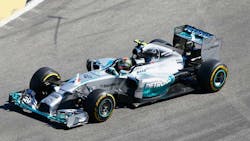Pirelli faced some of the hottest track temperatures seen all year at Hockenheim during free practice, peaking at 57 degrees centigrade. Despite this exceptional heat, the two softest compounds in the range – P Zero Yellow soft and P Zero Red supersoft – performed within the expected parameters at what is a demanding circuit in terms of traction and braking.
The high temperatures are not expected to last, with a changeable weather forecast for the rest of the weekend, including a possibility of rain. This means that the data gathered during the two sessions today may not necessarily be representative of qualifying and the race, so the teams will be forced to react to changing conditions. However, if the race remains dry, between two and three pit stops are anticipated.
Mercedes drivers led both free practice sessions, but the gaps between the teams are relatively small on the evidence of the lap times. However, this does not take into account the different fuel loads and set-ups that the teams were running, as they carried out their preparations for the German Grand Prix, on a track that was last used for Formula One two years ago.
Paul Hembery: “We’re seeing a time difference of about a second per lap between the two compounds at the moment, but we wouldn’t imagine track evolution to be a particularly key factor here. Instead, the weather is going to be the biggest question mark, with changeable conditions expected from here on. There’s also been a lot of debate about the removal of FRIC suspension but from what we can see so far, it is difficult to say what kind of impact it will have on the tire behavior. Despite these very high track temperatures, the two softest compounds in the range have performed as we expected.”
Pirelli fact of the day:
Many renowned German automotive companies like Audi, BMW, Mercedes and Porsche are among Pirelli’s customers for original equipment. Pirelli has two factories in Germany, including a MIRS (Modular Integrated Robotised System) factory in Breuberg, capable of producing 10 million tires per year. Breuberg is also an important training centre as well as a tire factory: most of Pirelli’s training for new road car tire engineers and new workers destined for the company’s most highly advanced factories all over the world takes place there. After Milan, it is Pirelli’s second most significant research and development facility.



